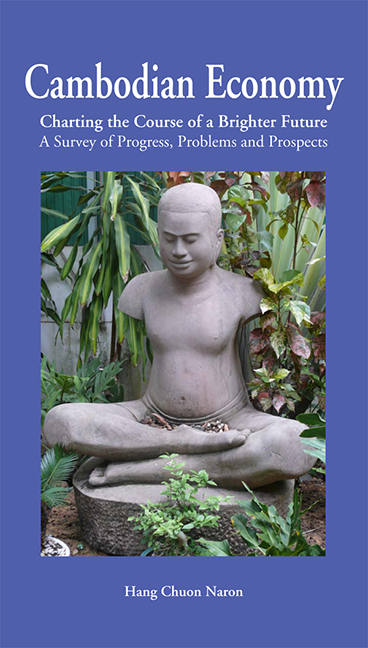 Cambodian Economy
Cambodian Economy Book contents
- Frontmatter
- Contents
- Foreword
- Preface
- INTRODUCTION
- Symbols and abbreviations
- PART I GEOGRAPHY AND POPULATION
- PART II MACROECONOMIC FRAMEWORK
- PART III THE CHALLENGE OF MODERNIZING AGRICULTURE
- PART IV THE CHALLENGE OF INDUSTRIALIZATION
- Chapter 10 Industrial Sector — An Overview
- Chapter 11 Private Sector Development
- Chapter 12 Industrial Policies
- PART V SERVICES AND INFRASTRUCTURE
- PART VI HUMAN RESOURCE DEVELOPMENT
- PART VII PUBLIC FINANCE
- PART VIII INTERNATIONAL ECONOMIC RELATIONS
- PART IX CONCLUSION
- Bibliography
- About the author
Chapter 11 - Private Sector Development
from PART IV - THE CHALLENGE OF INDUSTRIALIZATION
Published online by Cambridge University Press: 21 October 2015
- Frontmatter
- Contents
- Foreword
- Preface
- INTRODUCTION
- Symbols and abbreviations
- PART I GEOGRAPHY AND POPULATION
- PART II MACROECONOMIC FRAMEWORK
- PART III THE CHALLENGE OF MODERNIZING AGRICULTURE
- PART IV THE CHALLENGE OF INDUSTRIALIZATION
- Chapter 10 Industrial Sector — An Overview
- Chapter 11 Private Sector Development
- Chapter 12 Industrial Policies
- PART V SERVICES AND INFRASTRUCTURE
- PART VI HUMAN RESOURCE DEVELOPMENT
- PART VII PUBLIC FINANCE
- PART VIII INTERNATIONAL ECONOMIC RELATIONS
- PART IX CONCLUSION
- Bibliography
- About the author
Summary
The main motivator of industrial development, wealth creation and accumulation is the private sector. While much progress has been made in reviving the private sector after the Khmer Rouge regime it is yet to exhibit the dynamism of private initiative which has been the hallmark of the outstanding economic performance of the Southeast Asian countries in recent years. There are constraints and roadblocks which prevent it from playing an even greater role in development policy performance.
Manufacturing activities are by and large located in the private sector. The average annual growth of manufacturing industry's value added was 15.4% per year during 1994-2008. This is at variance with the behavior of the index of production for the formal manufacturing sector which shrank during this period. An explanation could be that in this period, the contribution of manufacturing to GDP came from the informal manufacturing sector
The size of the enterprise provides a basis for analyzing Cambodia's corporate sector. Three large groups of enterprises can be distinguished from this perspective: large businesses, small- and medium-sized businesses, and micro-businesses of the informal sector. The first three groups viz, large, medium and small businesses comprise the modern sector and engage in commercial scale activities. The broad definitions and distinguishing characteristics of each group are as follows:
Modern sector (SME Development Framework, 2005, p. 13):
• Big businesses: The company could be privately owned or State-owned. Privately owned big businesses are often a branch or partner of a foreign company. Big business is generally defined as having more than 100 permanent employees or having more than US$500,000 in capital invested, excluding land.
• Medium-size enterprises: In general these are funded by family capital and organized in a modern way. They generally employ from 51 to 100 workers with an annual turnover between US$250,000-US$500,000. They can be physically located, since they occupy fixed sites, are registered with the appropriate authorities, keep regular accounts, and often try to keep their identity distinct from that of the principal owners or promoters.[…]
- Type
- Chapter
- Information
- Cambodian EconomyCharting the Course of a Brighter Future - A Survey of Progress, Problems and Prospects, pp. 245 - 262Publisher: ISEAS–Yusof Ishak InstitutePrint publication year: 2012
